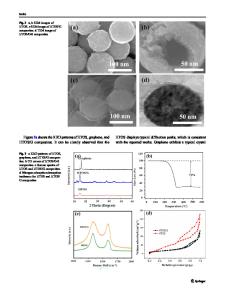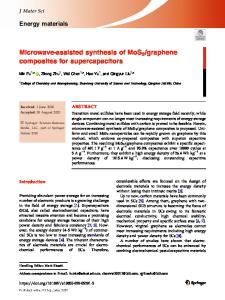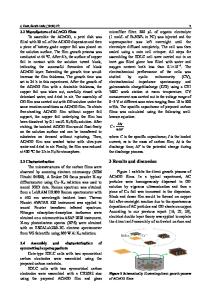Nanodiamond Converted Hollow Graphene Spheres as Electrodes for Supercapacitors
- PDF / 826,743 Bytes
- 6 Pages / 612 x 792 pts (letter) Page_size
- 68 Downloads / 357 Views
Nanodiamond Converted Hollow Graphene Spheres as Electrodes for Supercapacitors J. L. Li, S. Su, J. Li and H. Ye* School of Engineering and Applied Science, Aston University, Birmingham B4 7ET, UK *email: [email protected] ABSTRACT A porous composite formed of hollow graphene spheres with opens in them and amorphous carbon containing nitrogen and oxygenated groups has been fabricated by annealing the mixture of nanodiamond and polyacrylonitrile (PAN). Electrochemical tests on the electrode made of this material show that it may be a promising electrode material for supercapacitors. The relatively high capacitance is mainly attributed to the small inner electrical resistance, the huge specific surface area and the remaining nitrogen and oxygenated groups from the PAN. INTRODUCTION Over the past decade supercapacitors have been thought of as an effective way to deal with energy crisis and environmental problems. Carbonaceous substances including carbon nanotubes (CNTs), carbon aerogels and activated carbon have been studied because of their huge specific surface area and chemical stability under harsh environments. Recently, with a two-dimensional monolayer structure of sp2-bonded carbon atoms, graphene has been appreciated as a potential material in supercapacitors and Li ion batteries [16]. However, the re-stacking and agglomeration of graphene sheets when processing a graphene film eventually lead to the deterioration of their electrochemical performance. In order to overcome this obstacle, Huang et al tried incorporating CNTs into graphene films and they thus developed a novel binder-free graphene/CNT composite film as electrodes for supercapacitors [1]. The problem is that the inter-space between graphene oxide layers introduced by CNTs is difficult to control. As well known, diamonds become graphite at high temperatures. For nanodiamonds, when heated to a temperature above 1300oC, their grains convert to hollow graphene spheres, which are usually defective rather than a perfect round structure [7-8]. However, the resulting, deformed graphene shells have the potential to be used in electrodes for supercapacitors, due to their porous structure and excellent electrical conductivity. Our present work aims to build graphene films of a mortar and brick structure, i.e. hollow spheres of curved graphene layers derived from nanodiamonds being bricks bound by porous pyrolysed carbon as mortar (as shown in Figure 1). Such a structure allows ions to move between graphene layers while enabling good electrical contacts between graphene layers. EXPERIMENTAL The experimental was to convert nanodiamond to hollow graphene spheres that are bound by polyacrylonitrile (PAN) derived carbon. Nanodiamond grains of an average size of 20 nm were dispersed in PAN /dimethyl formamide solution (10 wt %) and pressed into pellets, which were later dried and pre-oxidised in air at 280 oC for PAN to get a stiffen network structure.
During subsequent annealing at 1500 oC, pre-oxidised PAN was converted to carbon with a disordered structure whil
Data Loading...











